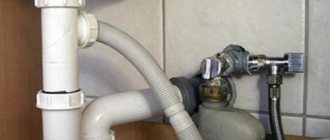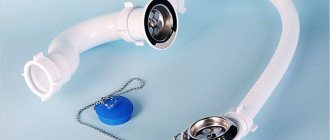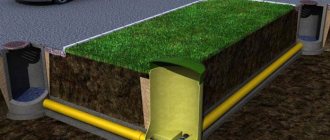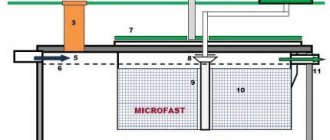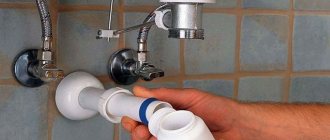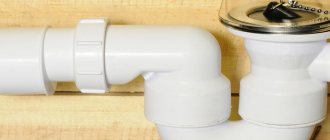Every apartment has at least one washbasin - an object without which no bathroom is equipped. However, in order for the facility to function properly, it must be equipped properly.
One of the integral components of the washbasin structure is the siphon - an object that is entrusted with the function of preventing water overflow, as well as eliminating unpleasant odors. Let us next consider the features of choosing a siphon, as well as the basic rules for its installation.
Device
First of all, it should be noted that a siphon is a fairly simple structure, which in appearance resembles a series of pipes connected to each other by flasks. In some cases, this drain element is presented in the form of one continuous pipe.
Speaking about the design features of a siphon under a bathroom sink, it should be noted that it has some standards that are observed for a long time. In accordance with them, the design of the siphon is:
- net;
- rubber gaskets;
- connection of a pipe or protective grille;
- outlet pipe;
- sewerage outlets;
- connecting nuts;
- frame.
Let us next consider the features of each component separately.
Speaking about the mesh (protective grill), it should be noted that it is a certain element that has 5-6 holes with a diameter of 1 cm. It is installed directly in the washbasin. This element is visible to the naked eye - it is located in the place where the water flows. The base of this part can be made of either plastic or metal.
As for the rubber gasket, it is designed to prevent water from seeping from the sink onto the floor. Practice shows that the color of such gaskets directly depends on the price and quality of the entire siphon: in expensive products they are presented in white, and in cheap ones - in black.
As for the outlet pipe, which is part of the siphon in the bathroom sink, it is used to connect other devices connected to the pipe from other plumbing elements installed nearby. Between the pipe and the protective grille there is a connection in the form of a screw, the diameter of which is 8 mm. Also, in addition to the pipe, other bends can be installed, presented in rigid or corrugated form. Additional elements of the siphon can also be connecting nuts made of the same material as the base of the structure. Most expert recommendations note that nuts of a high-quality design must be made of stainless steel, since if they are damaged, the entire structure will have to be replaced with a new one.
In devices of this type, various decorative linings are also installed, as well as reservoirs in which waste that falls into the sink is accumulated.
As for the base of the siphon, it consists of the entire body of the product. Let's talk about what they are like next.
How to assemble a bathroom siphon
Unfortunately, most kits are sold unassembled and you have to assemble them yourself. There is nothing difficult about this if you listen to the advice of professionals and follow the correct sequence.
Before purchasing, be sure to check the integrity of the threads and make sure there are no visible damages on the connecting elements.
Assembling a classic siphon
The assembly algorithm consists of six stages:
- Attach the chain connected to the stopper to the overflow hole cover.
- Place the drain pipe with the inserted seal outwards to the bathtub drain.
- Install a protective grille from the inside of the tank. Secure the structure with a nut or copper screw, but do not tighten it too much.
- Assemble the overflow drain in the same way, using a corrugated hose to attach to the siphon, onto which cone-shaped rubber gaskets and coupling nuts are first placed.
- Attach the removable elbow to the outlet. It acts as a water seal.
- Insert the adapter into the other end of the elbow to connect to the sewer.
Features of installation of a semi-automatic design
Installation of a semi-automatic device will require additional elements. Installation is done as follows:
- Initially, insert the connecting element for the sewer all the way into the drain neck. You do not need to use separate parts, since the seal is already present.
- Install a double gasket on the hole in the overflow block, and then begin to install the metal filter.
- Take flat metal covers and attach them to the control cable, then connect them to the water drainage hole.
- Secure the structure to the overflow with a bolt.
Corrugated siphons
Practice shows that most often corrugated siphons are found on the Russian market. Structures of this type are made of plastic with a folded structure. Due to the structural features, the design has the ability to fold and unfold perfectly, compressing into a tube of the required length. An additional advantage of this type of design is that it can be bent in any way. This allows you to place it anywhere. Practice shows that a siphon with a plastic corrugation is best suited for a sink, since it can be squeezed into any place without any problems and is quite simply connected to the drain.
The design of the corrugated siphon is distinguished by its simplicity: it contains a base, as well as a number of connecting nodes. The main advantage of this structure is that there are almost no leaks in a pipe of this type.
However, practice shows that the design of a sink siphon with plastic corrugation also has some negative features, which manifest themselves primarily in a low degree of resistance to sudden temperature changes. Also, when using such a design, it is necessary to take into account the fact that if fat gets into it, the pipe becomes clogged, to eliminate which you will have to dismantle the entire structure, clean it and install it back, or replace it with a new one.
Pipe siphons
Construction experts often note that an excellent option for a siphon for a bathroom sink would be a tubular structure, which is presented in a ready-made version and does not lend itself to any deformation.
Pipe siphons are presented in the form of a curved tube, which is made of metal or high-quality plastic. It should be noted that in such a design there is always a bend in which the water seal is formed, however, as a rule, it is small in size and shallow in depth.
Pipe siphons, according to people who operate them, have a number of disadvantages, which manifest themselves in the frequent formation of an unpleasant odor emanating from the structure, as well as constant blockage of the passage, as a result of which it is necessary to constantly disassemble the riser and clean it.
Siphons are not recommended for use in kitchen sinks, as food debris most often gets into them, as a result of which they will constantly need to be cleaned. The big disadvantage of such structures is that they are large in size, due to which, as a rule, nothing fits under the sink except a siphon.
Pipe siphons are an ideal design for a double sink. Some of them have double safety nets.
Bottle siphons
Among the popular designs are bottle siphons, which received this name due to their unique appearance - the middle part of the tube has a protrusion in the form of a bottle.
Such products are characterized by certain installation and operation features. Thus, it is best to trust the installation of these structures to professionals in the field of plumbing, but their subsequent disassembly and cleaning can be done independently - such processes are not difficult.
Experts often note that bottle siphons have one simple feature - they can easily be connected to the drain of any other device, for example, a washing machine or dishwasher. It should be noted that in this situation the connection occurs directly, without the use of extra sewerage outlets.
One of the positive qualities of the design in question is also the fact that it has a special element - an outlet, which collects all the debris that enters the pipe. It should be noted that existing blockages can be removed without much difficulty by removing only the lower part of the structure, without completely dismantling the riser.
Thanks to all the features and advantages of the design, it is often used to equip double plumbing fixtures, as well as to equip sinks with overflow.
How to make a choice
Before purchasing, you should find out the range of stores, pricing policy, choose a product using customer reviews (online store sites), listen to advice from experts (YouTube videos).
Basic steps for selecting the right model:
- choosing the type of siphon (location – kitchen, shower, bathroom sink);
- select the product material;
- determine the need for additional functions - double outlet, overflow, drain mechanism;
- measure the diameters of the drain, sewer (standard - 35, 40, 50 mm) holes;
- study the package – all the necessary components, absence of defective parts;
- color, quality of gaskets (black, white)
- material of fastening elements (bolts, nuts made of stainless steel)
- throughput capacity (several objects - increasing the cross-section of the log, several sewer outlets);
- cost, manufacturer, guarantee, quality certificate.
Dry siphons
One of the latest innovations in the field of plumbing is the dry siphon. This type of design gained great popularity immediately after its birth, due to its ability to prevent water from stagnating in the tube, which prevents unpleasant odors.
Dry siphons are quite often used in dachas, as well as in rooms where the water supply is strictly limited and there are certain heating problems.
The peculiarity of the operation of a siphon of this type is that when water enters it, a membrane made of rubber begins to open due to the movement of the flow. After the water supply stops, it contracts, as a result of which the flow hole is simply blocked.
Hidden and flat siphons
When considering the types of siphons, you should definitely pay attention to such a type of design as flat. A siphon for a sink of this type is used in a situation where, for some reason, it is impossible to install a corrugated or bottle siphon due to their size. Such structures are created mainly from plastic. Due to the small size of flat siphons for sinks, they are most often used in small bathrooms.
The main advantage of hidden siphons is that such structures are not visible to others. As practice shows, most often they are placed inside special boxes, niches and walls. As a rule, such niches and boxes are installed adjacent to sinks.
Pipes
Pipe siphons for a ceramic sink are a bent pipe made of plastic or metal. The bend acts as a water seal, preventing sewer odors from entering the home. However, due to the shallow depth, such a seal sometimes dries out, which can cause a musty atmosphere in the room. Siphons of this type are prone to frequent blockages, which is why they have to be disassembled and cleaned regularly. For prevention, it is recommended to pour Mole into the sink from time to time.
Due to frequent blockages, people try not to use pipe siphons to equip kitchen sinks. The fact is that the load on the washbasin in this room is considerable, and there is not always enough time to do frequent cleanings. Another significant disadvantage of this modification is its large dimensions. As a result, such a siphon, after installation, “eats up” almost the entire space under the sink. Therefore, we have to look for another storage location for detergents and household chemicals.
The advantages of pipe structures include the possibility of using them as a siphon for two sinks. Products of this type are equipped with a pair of inputs and grilles, which is very convenient for simultaneously connecting two sinks. As a rule, a siphon for two sinks is used in cases where the bathroom area is large and there is only one drain pipe.
What are siphons made of?
Experts in the field of plumbing strongly recommend paying attention to the material from which the structure is made - this is the primary indicator of its quality. Let us next consider the main features of each material.
Modern plumbing stores are ready to offer siphons made from the following materials:
- chromium;
- brass;
- copper;
- bronze;
- plastic.
Practice shows that chrome-plated siphons are the most popular - they are the most durable and retain their qualities for a long period. Moreover, many people are captivated by the beauty of the appearance of such products. In the interior, this element combines stunningly with towel rails, pipes and other integral elements of the kitchen and bathroom made of metal. When choosing a chrome, copper or brass structure, it is worth remembering that it needs proper care, otherwise the siphon will quickly lose the beauty of its appearance.
As for plastic sink siphons, they are less durable than metal structures, but despite this, they are in quite high demand due to the presence of a lot of positive qualities characteristic of them.
It is worth noting that plastic siphons are lightweight and also low in cost. In addition, such structures are quite easy to disassemble and clean, and you can also install them yourself without much difficulty. The advantage of siphons made from such material is that limescale deposits, which appear on metal products every now and then, do not form on their insides.
A significant disadvantage of plastic siphons is that they are subject to mechanical influence from the outside. That is why they need to be covered with ceramic elements or special boxes.
What materials are the devices made from?
The siphon for a ceramic sink must meet the required quality parameters. You can choose either a plastic or metal structure.
Available plastic products
Plastic devices are considered the cheapest option, which is why they are so popular. In addition, they have a simple design. There are not many connections provided here, so the device can be considered reliable.
There are different types of such siphons - for example, they are made of polypropylene, polyethylene and PVC. But the first option is considered more durable. Such devices are less sensitive to high temperatures and last longer. But PVC products are presented in a wider range. For example, you can find accessories for a two-piece sink or sinks installed close to each other.
Plastic devices have a smooth and even internal surface, so deposits of impurities that exist in waste water do not form on them. Some manufacturers coat them with antibacterial compounds that prevent strong dirt from settling.
Durable metal devices
Metal siphons are much more expensive than their plastic counterparts, but they also look noticeably better.
In the manufacture of devices, metal alloys based on bronze, copper, and brass can be used. Many brands use chrome plating. The accessories have an attractive design, are high-tech, and have good performance characteristics. However, they are not considered the most practical choice for the kitchen, but are more suitable for the bathroom vanity.
Metal products have their own peculiarity. In order for them to serve for a long time, they need to be installed correctly, which requires a precise fit, and it is difficult to reduce the size of such siphons. This is the main disadvantage of such devices, along with the high price and labor-intensive maintenance - in order to maintain the original appearance, you will have to spend a lot of time and effort.
Hidden installation of such accessories is not carried out at all. They are mounted where they will always be visible because they look like decoration.
About the sizes of sink siphons
Speaking about the sizes of the structures under consideration, it is worth noting that they differ in their diversity. If it is not possible to calculate the exact length of the tube, then you should give preference to those structures that can be deformed, based on personal preferences - corrugated ones.
Speaking about the sizes of siphons for dry-type sinks, it should be noted that currently their list is very limited - manufacturers produce such designs in two types: 32 and 40 mm. When choosing other types of structures, it is necessary to make the most accurate measurements. So, for example, in reality you need to clearly determine the size of the chrome siphon for the sink. After all, such a material cannot be deformed.
How to choose the size siphon for a sink? In this case, you should pay attention to what design capacity is needed for a particular situation. It is also necessary to take into account the total number of sources connected to it, as well as the degree of water pressure supplied. If during the operation of the siphon a powerful flow of water from several sources will pass through it, it is worth giving preference to those structures that have a large cross-section.
Otherwise, if the size of the sink siphon in the bathroom or kitchen is small, you may encounter an unpleasant phenomenon in the form of flooding. It is also worth paying attention to the fact that when planning an increased load on the device, it is better to give preference not to plastic or flat elements, but to metal ones. A small siphon for a sink can only be suitable if it receives a single, rather weak stream of water.
Features of the operation of siphon closing plugs
Thanks to the constant improvement of siphon devices, closing plug systems have not been left without attention. If in a conventional siphon you need to remove the plug by hand to release water, then in some modern models you do not need to wet your hands to drain the water from the font.
Two types of mechanisms can be distinguished:
- semi-automatic;
- click-clack (automatic).
Such systems are more convenient to use than conventional stoppers and are often pre-installed in modern acrylic bathtubs.
Semi-automatic mechanism
The semi-automatic siphon is equipped with a plug drive, which is a small cable. Shutting off and draining the water is controlled by turning a knob or lever. Most often, the handle is an overflow cap with a rotary ring, a button or a special valve.
Semi-automatic bath siphon.
Semi-automatic siphon for washbasin.
Advantages of the rotary mechanism:
- Ease of use;
- reliability and durability provided the product is of good quality;
- an interesting appearance if the lever is made, for example, in the shape of a vintage valve.
The cable is the most vulnerable part of a semi-automatic siphon. In inexpensive versions, it quickly fails, and the entire set will have to be replaced.
Click-clack siphon
You can now regulate the flow of water into the bath by simply pressing the plug at the bottom, which is done with your hand or foot.
The lid is secured by a pin with a spring, and the first press closes the drain. When pressed again, the lid opens and the water flows freely into the drain.
Siphon with click-clack system.
This type of siphon is liked by those who like to take water procedures in a horizontal position. However, as with semi-automatic models, the click-clack is difficult to repair if the spring breaks.
Recommendations for choosing a siphon
Experts in the field of plumbing installation and maintenance often give a lot of advice regarding the correct choice of siphons for sinks. What should you pay attention to when choosing a device? Let's look at some of the main points below.
First of all, the buyer should decide what type of sink he is choosing. So, if there is empty and visible space underneath, then you should give preference to products made of metal, which look beautiful and quite aesthetically pleasing. As for plastic structures, they look unattractive, so it is better to use them so that they are covered with something.
Despite the fact that the siphon is a relatively small detail, it is still worth choosing it so that it fits perfectly with the overall picture of the interior. If a countertop-type sink is installed in the bathroom, as well as a product made of stone, ceramics or glass, then in this case you should give preference to a design made of metal - the elements will look very harmonious with each other. As for the type of product, it is advisable to give preference to bottle or tube - in this situation they look quite expensive, and they are also characterized by ease of use. When choosing a design, it is advisable to remember that modern manufacturers offer a large selection of product colors, this allows you to select them to suit a specific interior design.
When choosing a siphon for a sink, the size of the bathroom or kitchen must be taken into account. If the space is small, then a corrugated type design is perfect for it - they can take any shape and be located in any area. Practice shows that when using a siphon of this type next to the sink, you can easily place other objects that need to drain water.
When choosing a siphon for a summer house or a house that has heating problems, you need to pay attention to dry-type structures.
When choosing an object, you need to pay attention not only to the type of product, but also to its throughput. Practice shows that a siphon for a standard size sink will not be suitable if a flow of water from different objects with high pressure passes through it. In such a situation, it is worth choosing a design with a non-standard cross-sectional diameter.
Modern siphons offered on the market can be divided into smooth-walled and ribbed. Manufacturers increasingly recommend giving preference to smooth-walled products, citing the fact that fewer blockages form in them.
Some siphons have a check valve in their design. Its main action is aimed at preventing the reverse flow of liquid, as a result of which the occurrence of an unpleasant sewer odor can be avoided. Installing this type of siphon is appropriate if the pipes are located at a slight slope.
During the purchasing process, you should also pay attention to the cost of the product - it determines its quality and, as a result, its service life. Practice shows: metal products are much more expensive than plastic ones, but their service life is longer, which is determined, first of all, by their resistance to external mechanical influences, as well as the strength of the material.
When choosing a siphon, you need to pay attention to those configurations that have a special purpose. Thus, modern manufacturers supply the plumbing market with special siphons for kitchen sinks, the size of which fully corresponds to the standard throughput, and the tubes themselves are often protected from sticking of grease and excessive clogging.
What should you pay attention to once you have fully decided on the choice of product? When purchasing a structure, you need to check whether all the parts are in place. If you purchase a branded product, a quality certificate must be included with it. It must certainly reflect the characteristics of the product and the material from which it is made. Also, any good siphon must be accompanied by a warranty card. Based on the warranty period stated in the document, you can determine the quality of the design: the longer it is, the more confident the manufacturer is that the product provided by him will last for a long time.
During the purchasing process, it is also recommended to personally measure the length of the pipe and its diameter.
Possible materials of manufacture
Materials used to create siphons:
- Metal. The products are distinguished by their decorative appeal and increased strength, but over time they can be subject to corrosion and oxidation. They are usually made of brass, less often - of bronze, copper, stainless steel. The most common models are chrome plated. The main disadvantage is the difficulty in selecting the size, because shortening a metal pipe will not be easy.
Chrome-plated products are chosen for wall-hung and countertop sinks. Being visible, they not only do not spoil the design of the washbasin, but also complement it favorably.
- Plastic. Due to their affordable price and good performance, plastic products are in great demand and popularity. They are lightweight, simple in design, and resistant to household chemicals. In the connecting nodes, the plastic siphon is equipped with rubber seals, which increases the service life of the product and its tightness. The product range of many manufacturers includes models with a special antibacterial coating of the internal cavity, which prevents the settling of grease and dirt and reduces the rate of clogging.
Siphon installation rules
In order for the purchased siphon to function correctly, it must be assembled in accordance with the requirements specified in the instructions.
The sequence of assembly of the structure is as follows:
- A large flat gasket should be placed on the large hole in the main tube and the existing cap should be screwed to the side.
- It is necessary to screw a union-type nut onto the pipe, and a cone gasket on top of it. Then the assembled structure must be inserted into the upper hole and screwed tightly without squeezing it.
- If a siphon with an overflow is being assembled, this part must be connected to the outlet of the pipe. To do this, you first need to put a nut on the outlet, and a ring gasket on top of it. Next, the assembled structure must be connected to the overflow, placing it with the blunt end towards it and tightening it with a nut. If the siphon design does not provide for an overflow, this assembly step must be skipped.
- At the final stage of assembly, you should take the corrugated pipe and carefully put a union nut on it, and a cone-type gasket on top of it. After this, the pipe must be screwed to the siphon, thereby completing the assembly process.
In order to install the assembled siphon directly into the sink, you must follow the following recommendations:
- First of all, you should put the o-ring on the pipe, placing it with the strips facing up. The second ring included in the kit should be pulled over a metal mesh, which should then be placed above the sink.
- Next, you need to adjust the siphon to the drain hole in the sink.
- The screw should be screwed into the grille.
- Using the rigid tube that comes with the siphon, you need to connect the assembled structure to the sewer. It should be noted that at this stage the process occurs much faster in relation to the corrugated pipe.
- At the final stage, you need to run water through the siphon, checking the tightness and correctness of its installation.
Installation of a siphon with overflow
To do this work, you should carefully read the instructions that come with the product. The greatest attention should be paid to the water seal. Here is a brief outline of the key points for self-installation:
- You should check the recessedness of the mesh on the drain hole. If it is located too high, then the water will not go down the drain efficiently and will begin to collect in the sink.
Siphon installation - A conical gasket and a special nut are put on the outlet pipe coming out from the bottom of the sink. It is necessary to create a gap of 3-5 mm between the gasket and the edge of the pipe.
- When tightening the nuts during installation, do not use a wrench. It is better to do all twisting by hand. By screwing with a wrench, you can put excessive stress on the plastic elements and cause a crack in them. Such a product will be unusable in the future.
- A tight plug must be installed on unused outlets.
- After installation, you need to check the functionality of the entire structure. To do this, open the tap to full power to see how the siphon reacts to high water pressure. On a well-installed siphon, liquid will not ooze from any joint.
This is interesting: The nuances of installing a sink above a washing machine, the pros and cons of such a solution, choice
To prevent leaks, it is necessary to use sealant during installation. However, it must be used carefully, since in the future such a structure will be very difficult to dismantle.
The best siphon manufacturers
If you want to purchase a design of the type in question of good quality, you should give preference to those that are put on the market by trusted manufacturers. Today, among the most popular brands are the following:
- McAlpine (Scotland);
- Hansgrohe (Germany);
- Akvater (Russia);
- Grohe (Germany);
- Viega (Germany);
- Alcaplast (Czech Republic).
Practice shows that the designs presented by the listed manufacturers are in an expensive price category, but according to statistics they last much longer than their cheaper counterparts.
